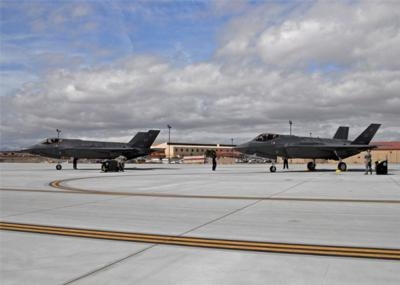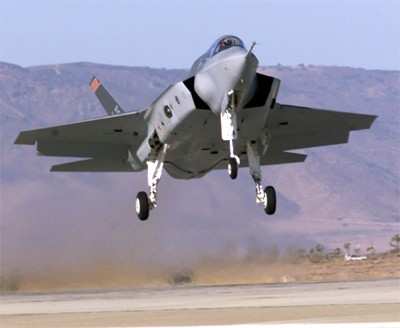Pilots Hand-Selected From Among The Best In Several Types Of Aircraft
The F-35 Lightning II at California's Edwards AFB entered a new phase of testing with the arrival of the first two operational test aircraft March 6.

Team members from the 53rd Wing's 31st Test and Evaluation Squadron, a tenant unit at Edwards, will determine how to best tactically operate the F-35A conventional takeoff and landing variant of the fifth-generation fighter. Another 53rd Wing squadron, the 422nd Test and Evaluation Squadron at Nellis AFB, NV, also received F-35As and will take part in the operational test process of the new aircraft.
"As part of the Joint Operational Test Team, we take the aircraft hardware and software released from developmental test, our training from the 33rd Fighter Wing at Eglin (AFB, Fla.), the administrative and logistics support we get from the Joint Program Office and Lockheed Martin, and we integrate all of these disparate elements with maintenance practices, tactics, techniques and procedures required to create an incredibly lethal weapon system that can go out and win the nation's wars," said Lt. Col. Steven J. Tittel, the 31st TES commander.
"We've got a brand new tool with a whole new set of capabilities that has never been used by the combat air forces. We have to take that tool and find out the best way to utilize it, to go out and defeat an enemy on the battlefield," he continued.
With the F-35A slated to replace the A-10 and F-16, pilots selected for F-35 operational test and evaluation were hand-picked from among the best in the Air Force and bring a wide variety of expertise to the program. "Basically, this jet is going to encompass all of our air-to-ground roles and including some of our air-to-air roles as well. What they wanted was expertise from all those different platforms that will eventually be replaced by the F-35," said Maj. Matthew L. Bell, the 31st TES Operations Flight commander. "The bottom line is we have all these jets with specialized capabilities and you want to make sure that if you're eventually going to replace these airframes with one jet, none of that corporate knowledge is lost,"
Bell, an A-10 Thunderbolt II pilot with more than 1,500 hours in the jet transitioned to the F-35 in December of 2012, bringing extensive knowledge of air-to-ground capabilities, close-air support, and forward-air-control to the operational test and evaluation program. Five additional pilots will be working alongside Bell with F-15E Strike Eagle and F-16 Fighting Falcon experience that adds a dimension of air-to-air expertise and an in-depth knowledge of deep strike capabilities. "We did that intentionally. The F-35 is designed to replace different legacy aircraft throughout the fleet. So we pulled together as much experience from different mission sets as we possibly could so we have a good baseline for evaluating the aircraft across all the missions it will be expected to perform in the future," Tittel said.

Together, their corporate knowledge will help shape combat tactics of the F-35A. "We're not necessarily trying to make this jet operate exactly like an F-15, F-16 or an A-10; we're trying to figure out how to make an F-35 operate tactically. We're trying to combine all that knowledge into a new set of tactics for the U.S.' newest fighter and make sure that those tactics all make sense," Bell said.
The Air Force also recruited top maintainers to support the F-35 operational test and evaluation efforts. These maintainers have been diligently preparing for the work ahead.
Formalized testing will evaluate the production-representative F-35A, as well as support equipment and the logistics supply system in an operationally representative environment; with the ultimate goal of determining whether or not the program is suitable and effective in a real-world combat environment. It encompasses the aircraft's survivability, as well as the ability to support and execute flight operations and maintenance at home and in deployed locations.
(USAF Image)
 ANN FAQ: Submit a News Story!
ANN FAQ: Submit a News Story! Aero-News: Quote of the Day (06.12.24)
Aero-News: Quote of the Day (06.12.24) ANN's Daily Aero-Linx (06.12.24)
ANN's Daily Aero-Linx (06.12.24) ANN's Daily Aero-Term (06.12.24): Adcock Range
ANN's Daily Aero-Term (06.12.24): Adcock Range Airborne Affordable Flyers 06.06.24: 200th ALTO, Rotax SB, Risen 916iSV
Airborne Affordable Flyers 06.06.24: 200th ALTO, Rotax SB, Risen 916iSV




